RBSE Solutions for Class 12 Maths Chapter 6 Application of Derivatives Ex 6.3
Rajasthan Board RBSE Solutions for Class 12 Maths Chapter 6 Application of Derivatives Ex 6.3 Textbook Exercise Questions and Answers.
Rajasthan Board RBSE Solutions for Class 12 Maths in Hindi Medium & English Medium are part of RBSE Solutions for Class 12. Students can also read RBSE Class 12 Maths Important Questions for exam preparation. Students can also go through RBSE Class 12 Maths Notes to understand and remember the concepts easily.
RBSE Class 12 Maths Solutions Chapter 6 Application of Derivatives Ex 6.3
Question 1.
Find the slope of the tangent to the curve y = 3x4 - 4x at x = 4.
Answer:
Differentiating y = 3x4 - 4x w.r.t x
\(\frac{d y}{d x}\) = 3 × 4x3 - 4 = 12x3 - 4
At x = 4, \(\frac{d y}{d x}\) = 12 × (4)3 - 4 = 12 × 64 - 4
= 768 - 4 = 764
∴ \(\left(\frac{d y}{d x}\right)_{(x=4)}\) = 764 ⇒ m = 764
Thus, slope of the tangent at x = 4 is 764.

Question 2.
Find the slope of the tangent to the curve
y = \(\frac{x-1}{x-2}\), x ≠ 2 at x = 10
Answer:
Differentiating y = \(\frac{x-1}{x-2}\) w.r.t. x
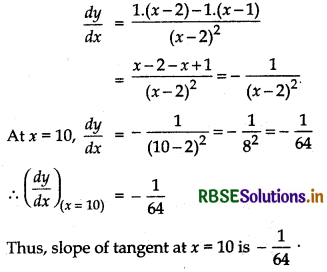
Question 3.
Find the slope of the tangent to the curve y = x3 - x + 1 at the point whose x-coordinate is 2.
Answer:
Differentiating y = x3 - x + 1 w.r.t. x
\(\frac{d y}{d x}\) = 3x2 - 1
At x = 2, \(\frac{d y}{d x}\) = 3(2)2 - 1 = 12 - 1 = 11
∴ \(\left(\frac{d y}{d x}\right)_{(x=2)}\) = 11
Thus, at x = 2 slope of tangent is 11.
Question 4.
Find the slope of the tangent to the curve y = x3 - 3x + 2 at the point whose x-co-ordinate is 3.
Answer:
Differentiating y = x3 - 3x + 2 w.r.t. x
\(\frac{d y}{d x}\) = 3x2 - 3
At x = 3, \(\frac{d y}{d x}\) = 3 × 32 - 3 = 27 - 3 = 24
∴ \(\left(\frac{d y}{d x}\right)_{(x=3)}\) = 24 ⇒ m = 24
Thus, at x = 3 slope of tangent is 24.

Question 5.
Find the slope of the normal to the curve x = a cos3 θ, y = a sin3 θ at θ = π/4.
Answer:
We have x = a cos3 θ and y = a sin3 θ.
Differentiating x and y w.r.t. θ
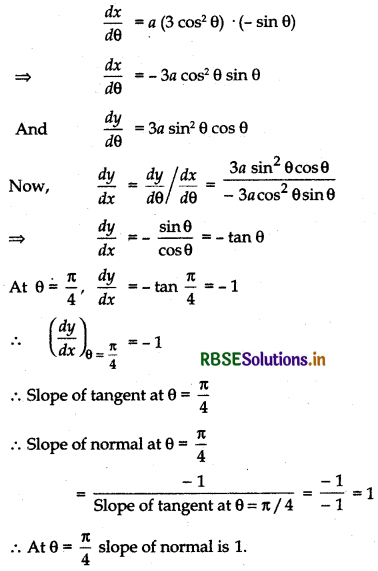
Question 6.
Find the slope of the normal to the curve x = 1 - a sin θ, y = b cos2θ at θ = \(\frac{\pi}{2}\).
Answer:
We have x = 1 - a sin θ, y = b cos2 θ.
Differentiating x and y w.r.t. θ
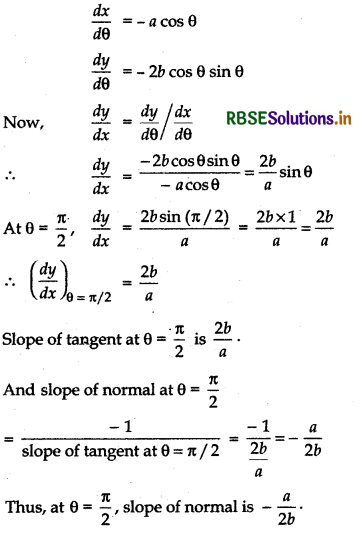

Question 7.
Find points at which the tangent to the curve y = x3 - 3x2 - 9x + 7 is parallel to the x-axis.
Answer:
We have y = x3 - 3x2 - 9x + 7
Differentiating w.r.t. x
\(\frac{d y}{d x}\) = 3x2 - 6x - 9
Since, tangents are parallel to x-axis
∴ \(\frac{d y}{d x}\) = 0
⇒ 3x2 - 6x - 9 = 0
⇒ 3(x2 - 2x - 3) = 0
⇒ (x - 3) (x + 1) = 0
⇒ x - 3 = 0 or x + 1 = 0
⇒ x = 3 or x = - 1
Putting x = 3 and x = - 1 in equation y = x3 - 3x2 - 9x + 7
y = (3)3 - 3(3)2 - 9 × 3 + 7
⇒ y = 27 - 27 - 27 + 7
⇒ y = - 20
and y = (- 1)3 - 3(- 1)2 - 9(- 1) + 7
⇒ y = - 1 - 3 + 9 + 7
⇒ y = 12
Hence, required points are (3, - 20) and (- 1, 12).
Question 8.
Find a point on the curve y = (x - 2)2 at which the tangent is parallel to the chord joining the points (2, 0) and (4, 4).
Answer:
Slope of line joining the points (2, 0) and(4, 4)
m = \(\frac{4-0}{4-2}=\frac{4}{2}\) = 2
Differentiating y = (x - 2)2 w.r.t. x
\(\frac{d y}{d x}\) = 2(x - 2) ......... (1)
Since, tangent is parallel to the line joining the points (2, 0) and (4, 4).
∴ Slope of tangent = Slope of line joining the points (2, 0) and (4, 4)
⇒ \(\frac{d y}{d x}\) = 2 ........ (2)
From equations (1) and (2)
2(x - 2) = 2 ⇒ x - 2 = 1
⇒ x = 1 + 2 = 3
Putting x = 3 in y = (x - 2)2
y = (3 - 2)2 = 12 = 1
Hence, required points is (3, 1).

Question 9.
Find the point on the curve y = x3 - 11x + 5 at which the tangent is y = x - 11.
Answer:
Differentiating y = - x3 - 11x + 5 w.r.t. x
\(\frac{d y}{d x}\) = 3x2 - 11 ...... (i)
Given, slope of tangent = 1 ...... (ii)
From Eqs. (i) and (ii)
∴ 1 = 3x2 - 11 ⇒ 3x2 = 12
⇒ x2 = 4 ⇒ x = ±2
When x = 2, then y = 23 - 11 × 2 + 5 = - 9
When x = - 2, then y = (- 2)3 - 11(- 2) + 5 = 19
y = x - 11 is not the tangent at point (- 2, 19).
Since LHS. = 19
R.H.S. = - 2 - 11 = - 13
19 ≠ - 13
Hence, y = x - 11 is tangent at point (2, - 9).
Question 10.
Find the equation of all lines having slope - 1 that are tangents to the curve
y = \(\frac{1}{x-1}\), x ≠ 1
Answer:
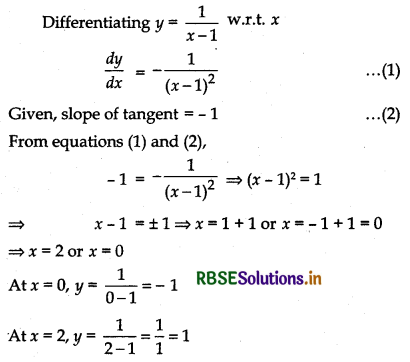
∴ At (0, - 1) and (2, 1) slope of tangent is - 1.
Equation of tangent at point (0, - 1)
y - (- 1) = - 1(x - 0)
⇒ y + 1 = - x ⇒ x + y + 1 = 0
And at point (2, 1), equation of tangent
y - 1 = - 1(x - 2) ⇒ y - 1 = - x + 2
⇒ x + y = 2 + 1 ⇒ x + y - 3 = 0
Hence, x + y + 1 = 0 and x + y - 3 = 0 are required tangents.

Question 11.
Find the equation of all lines having slope 2 which are tangents to the curve
y = \(\frac{1}{x-3}\), x ≠ 3
Answer:
Differentiating y = \(\frac{1}{x-3}\) w.r.t. x
\(\frac{d y}{d x}=-\frac{1}{(x-3)^{2}}\) ...... (1)
Given, slope of tangent = 2 ......... (2)
From equations (1) and (2),
2 = - \(\frac{1}{(x-3)^{2}}\)
⇒ 2(x - 3)2 = - 1 ⇒ (x - 3)2 = - \(\frac{1}{2}\)
which is not possible since square of real number cannot be negative (x ∈ R, x2 > 0).
Hence, curve has no tangent with slope 2.
Question 12.
Find the equations of all lines having slope 0 which are tangent to the curve
y = \(\frac{1}{x^{2}-2 x+3}\)
Answer:
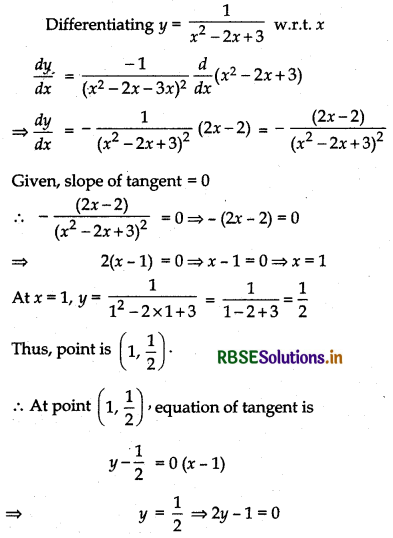
Hence, required equation of tangent is 2y - 1 = 0 at point \(\left(1, \frac{1}{2}\right)\).
Question 13.
Find points on the curve \(\frac{x^{2}}{9}+\frac{y^{2}}{16}\) = 1 at which the tangents are (i) parallel to x-axis (ii) parallel to y-axis
Answer:
Differentiating \(\frac{x^{2}}{9}+\frac{y^{2}}{16}\) = 1 w.r.t. x

(i) When tangent is parallel to x-axis
\(\frac{d y}{d x}\) = 0 ⇒ - \(\frac{16 x}{9 y}\) = 0 ⇒ x = 0
Putting x = 0 in equation \(\frac{x^{2}}{9}+\frac{y^{2}}{16}\) = 1
y2 = 16 ⇒ y = ±4
Thus, at points (0, ±4) tangents are parallel to x-axis.
(ii) When tangent is parallel toy-axis, i.e., perpendicular to x-axis, then
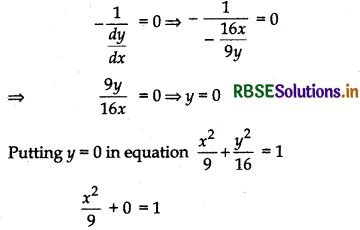
⇒ x2 = 9 ⇒ x = ± 3
Thus, at points (±3, 0) tangents are parallel to y-axis.

Question 14.
Find the equation of the tangent and normal to the given curves at the indicated points:
(i) y = x4 - 6x3 + 13x2 - 10x + 5 at (0, 5)
Answer:
Given, y = x4 - 6x3 + 13x4 - 10x + 5
Differentiating w.r.t. x
\(\frac{d y}{d x}\) = 4x3 - 18x2 + 26x - 10
At(0, 5), \(\frac{d y}{d x}\) = 4 × 0 - 18 × 0 + 26 × 0 - 10 = - 10
∴ \(\left(\frac{d y}{d x}\right)_{(0,5)}\) = - 10
∴ At (0, 5) slope of tangent = - 10
∴ Equation of tangent at (0, 5) is
y - 5 = - 10(x - 0) ⇒ y - 5 = - 10x
⇒ y + 10x - 5 = 0 ⇒ 10x + y - 5 = 0
∴ At point (0, 5) slope of normal
= \(\frac{-1}{\text { Slope of tangent }}=\frac{-1}{-10}=\frac{1}{10}\)
Thus, at (0, 5) equation of normal is
y - 5 = \(\frac{1}{10}(x - 0)\)
⇒ 10(y - 5) = x ⇒ 10y - 50 = x
⇒ 10y - x - 50 = 0 ⇒ x - 10y + 50 = 0
Thus, equation of tangent is 10x + y - 5 = 0
And equation of normal is x - 10y + 50 = 0
(ii) y = x4 - 6x4 + 13x2 - 10x + 5 at (1, 3)
Answer:
Given, y = x4 - 6x3 + 13x2 - 10x + 5
Differentiating w.r.t. x
\(\frac{d y}{d x}\) = 4x3 - 18x2 + 26x - 10
At(1, 3), \(\frac{d y}{d x}\) = 4 × 13 - 18 × 12 + 26 × 1 - 10 = 2
∵ \(\left(\frac{d y}{d x}\right)_{(1,3)}\) = 2
∴ At (1, 3), slope of tangent = 2
And at (1,3) slope of normal
= \(\frac{-1}{\text { Slope of tangent at point }(1,3)}=-\frac{1}{2}\)
Now, equation of tangent at point (1, 3) is
y - 3 = 2(x - 1) ⇒ y - 3 = 2x - 2
⇒ y - 2x = 3 - 2 = 1 ⇒ 2x - y + 1 = 0
And equation of normal at point (1, 3) is
y - 3 = - \(\frac{1}{2}(x - 1)\) ⇒ 2(y - 3) - 1(x - 1)
⇒ 2y - 6 - x + 1 = x + 2y - 6 - 1 = 0
⇒ x + 2y - 7 = 0
Thus, equation of tangent is 2x - y + 1 = 0
and equation of normal is x + 2y - 7 = 0
(iii) y = x3 at (1, 1)
Answer:
Given, y = x3
Differentiating y = x w.r.t. x
\(\frac{d y}{d x}\) = 3x2
At point (1, 1), \(\frac{d y}{d x}\) = 3 × 12 = 3
∴ \(\left(\frac{d y}{d x}\right)_{(1,1)}\) = 3
∴ At point (1, 1) slope of tangent = 3
And at point (1, 1) slope of normal
= \(\frac{-1}{\text { Slope of normal at point }(1,1)}=-\frac{1}{3}\)
Slope of normal at point (1, 1) =
At point (1, 1), equation of tangent
y - 1 = 3(x - 1) ⇒ y - 1 = 3x - 3
⇒ y - 3x + 3 - 1 = 0 ⇒ y - 3x + 2 = 0
⇒ 3x - y - 2 = 0
And equation of normal at (1, 1)
y - 1 = - \(\frac{1}{3}\)(x - 1) ⇒ 3(y - 1) = - 1(x - 1)
⇒ 3y - 3 - x + 1
⇒ x + 3y - 3 - 1 = 0
⇒ x + 3y - 4 = 0
Thus, equation of tangent is 3x - y - 2 = 0
And equation of normal is x + 3y - 4 = 0

(iv) y = x2 at (0, 0)
Answer:
Given, y = x2
Differentiating y = x2 w.r.t. x
\(\frac{d y}{d x}\) = 2x
At (0, 0), \(\frac{d y}{d x}\) = 2 × 0 = 0
∴ \(\left(\frac{d y}{d x}\right)_{(0,0)}\) = 0
At (0, 0) slope of tangent = 0
And at (0, 0) equation of tangent is
y - 0 = 0(x - 0) ⇒ y = 0
Since normal is ⊥r to tangent.
Hence, equation of normal, x = 0
Note.: Here tangent is x-axis (y = 0) and normal is y-axis (x = 0).
(v) x = cos t, y = sin t at t = π/4
Answer:
Given, x = cos t, y = sin t
Differentiating x and y w.r.t. t
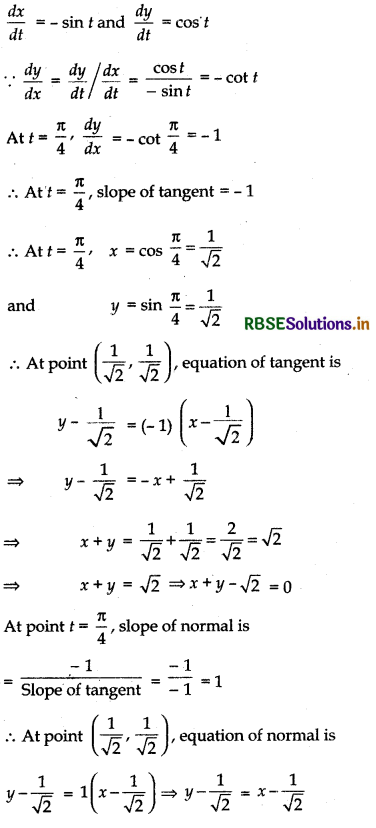
y = x
Thus, equation of tangent is x + y - √2 = 0
and equation of normal is y = x

Question 15.
Find the equation of the tangent line to the curve y = x2 - 2x + 7 which is
(a) parallel to the line 2x - y + 9 = 0
Answer:
Differentiating y = x2 - 2x + 7 w.r.t. x
\(\frac{d y}{d x}\) = 2x - 2
For slope of line 2x - y + 9 = 0
2x + 9 = y ⇒ 2x - y + 9 = 0
∴ Slope of line = -\(\frac{a}{b}=-\frac{2}{(-1)}\) = 2
Thus, slope of line 2x - y + 9 is 2.
Since, tangent is parallel to line 2x - y + 9 = 0.
Thus, slope of tangent = slope of line
∴ \(\frac{d y}{d x}\) = 2 ⇒ 2x - 2 = 2
⇒ 2(x - 1) = 2 ⇒ x - 1 = 1
⇒ x = 1 + 1 = 2
Putting x = 2 in y = x2 - 2x + 7
y = 22 - 2 × 2 + 7 = 4 - 4 + 7 = 7
∴ Point is (2, 7).
∴ At point (2, 7), equation of tangent is
y - 7 = 2(x - 2) ⇒ y - 7 = 2x - 4
⇒ 2x - y - 4 + 7 = 0 ⇒ 2x - y + 3 = 0
Hence, equation of tangent is 2x - y + 3 = 0
(b) perpendicular to the line 5y - 15x = 13
Answer:
For slope of line 5y - 15x = 13
5y = 15x + 13 ⇒ y = 3x + \(\frac{13}{5}\)
∴ Slope of given line = 3
∵ Tangent is perpendicular to line
5y - 15x = 13
∴ Slope of tangent = \(\frac{1}{\text { slope of given line }}=-\frac{1}{3}\)
But slope of tangent = 2x - 2
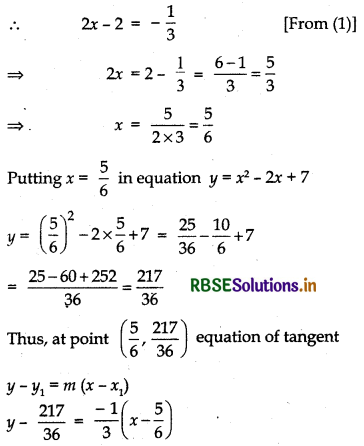
⇒ 36y - 217 = - 12(x - 5/6)
(Multiplying both sides by 36)
⇒ 36y - 217 = - 12x + 12 × 5/6
⇒ 36y - 217 - 12x + 10
⇒ 12x + 36y - 10 - 217 = 0
⇒ 12x + 36y - 227 = 0
Thus, 12x + 36y - 227 = 0 is the required equation of tangent.

Question 16.
Show that the tangents to the curve y = 7x3 + 11 w.r.t at the points where x = 2 and x = - 2 are parallel.
Sol.
Differentiating y = 7x3 + 11 w.r.t. x
\(\frac{d y}{d x}\) = 7 × 3x2
At point x = 2 slope of tangent
\(\frac{d y}{d x}\) = 7 × 3(2)2 = 7 × 3 × 4 = 84
At x = - 2 slope of tangent
\(\frac{d y}{d x}\) = 7 × 3(- 2)2 = 7 × 3 × 4 = 84
Thus, at x = 2 and x = - 2, slope of tangent are same.
∴ At point x = 2 and x = - 2, tangents are parallel.
Hence Proved.
Question 17.
Find the points on the curve y = x3 at which the slope of the tangent is equal to the y-coordinate of the point.
Answer:
Differentiating y = x3, w.r.t. x
\(\frac{d y}{d x}\) = 3x2
At point (x1, y1), slope of tangent = 3x12
We have, 3x12 = y1 ..... (1)
Again (x1, y1) lies on curve y = x3
∴ y1 = x13 ........ (2)
From equations (1) and (2)
x13 = 3x12 ⇒ x13 - 3x12 = 0
⇒ x12(x1 - 3) = 0 ⇒ x1 = 0 or x1 = 3
For x1 = 0, y1 = 03 = 0
For x1 = 3, y1 = 31 = 27
Thus, (0, 0) and (3, 27) are required points.
Question 18.
For the curve y = 4x3 - 2x5, find all the points at which the tangent passes through the origin.
Answer:
Let the point be (x1, y1).
y = 4x3 - 2x5 ........ (i)
∵ Differentiating equation (1), w.r.t. x .
\(\frac{d y}{d x}\) = 4 × 3x2 - 2 × 5x4
∴ \(\frac{d y}{d x}\) = 12x2 - 10x4
∴ Slope of tangent at point (x1, y1)
\(\left(\frac{d y}{d x}\right)_{\left(x_{1}, y_{1}\right)}\) = 12x12 - 10x14
∵ Point (x1, y1) lies on curve y = 4x3 - 2x5
∴ y1 = 4x13 - 2x15 ......... (2)
Now, at point (x1, y1) equation of tangent
y - y1 = (12x12 - 10x14) (x - x1)
Since, tangent passes through (0, 0)
∴ 0 - y1 = (12x12 - 10x14) (0 - x1)
⇒ - y1 = - x1(12x12 - 10x14)
⇒ y1 = 12x13 - 10x15 ........ (3)
From equations (2) and (3),
12x13 - 10x15 = 4x13 - 2x15
⇒ 12x13 - 4x13 = 10x15 - 2x15
⇒ 8x13 = 8x15 ⇒ 8x13 - 8x15 = 0
⇒ 8x13 (1 - x12) = 0 ⇒ x1 = 0, 1 - x12 = 0
⇒ x1 = 0, x12 = 1 ⇒ x1 = 0, x1 = ±1
Equation of curve y = 4x3 - 2x5
x1 = 0, y1 = 0
For x1 = 1, y1 = 4 × 13 - 2 × 15 = 2
For x1 = - 1, y1 = 4(- 1)3 - 2(- 1)5 = - 4 + 2 = - 2
Hence, required points are (0, 0), (1, 2) and (- 1, - 2).

Question 19.
Find the points on the curve x2 + y2 - 2x - 3 = 0 at which the tangents are parallel to the x-axis.
Answer:
Differentiating x2 + y2 - 2x - 3 = 0 w.r.t. x
2x + 2y\(\frac{d y}{d x}\) - 2 = 0
⇒ 2y\(\frac{d y}{d x}\) = 2 - 2x
⇒ \(\frac{d y}{d x}=\frac{2(1-x)}{2 y}=\frac{1-x}{y}\)
Since, tangent is parallel to x-axis
∴ \(\frac{d y}{d x}\) = 0 ⇒ \(\frac{1-x}{y}\) = 0
⇒ 1 - x = 0 ⇒ x = 1
Putting x = 1 in equation, x2 + y2 - 2x - 3 = 0
12 + y2 - 2 × 1 - 3 = 0
⇒ y2 + 1 - 2 - 3 = 0
⇒ y2 - 4 = 0
⇒ y2 = 4
⇒ y = ± 2
Thus, required points are (1, 2), (1, - 2).
Question 20.
Find the equation of the normal at the point (am2, am3) for the curve ay2 = x3.
Answer:
Differentiating ay2 = x3, w.r.t. x
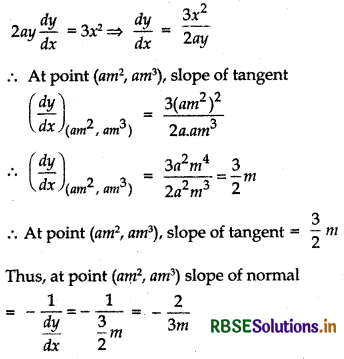
∴ Equation of normal at point (am2, am3)
y - am3 = - \(\frac{2}{3 m}\) (x - am2)
⇒ 3my - 3am4 - 2x + 2am2
⇒ 2x + 3my - 3am4 - 2am2 = 0
⇒ 2x + 3my - am2(3m2 + 2) = 0

Question 21.
Find the equation of the normals to the curve y = x3 + 2x + 6 which are parallel to the line x + 14y + 4 = 0.
Answer:
Differentiating y = x3 + 2x + 6, w.r.t. x
\(\frac{d y}{d x}\) = 3x2 + 2 (Slope of tangent)
Since, normal is parallel to x + 14y + 4 = 0.
Thus, - \(\frac{1}{\frac{d y}{d x}}\) = slope of tine x + 14y + 4 = 0
⇒ - \(\frac{1}{3 x^{2}+2}\) = - \(\frac{1}{14} \)(Slope of normal)
⇒ 3x2 + 2 = 14 ⇒ 3x2 = 12
⇒ x2 = 4⇒ x = ±2
Putting x = 2 in y = x3 + 2x + 6,
y = 23 + 2 × 2 + 6 = 8 + 4 + 6 = 18
∴ Point is (2, 18).
At x = - 2, y = (- 2)3 + 2 × (- 2) + 6 = - 6
∴ Point is ( - 2, - 6).
∴ Equation of normal at point (2, 18) is
y - 18 = - \(\frac{1}{14}\)(x - 2)
⇒ 14(y - 18) = - 1(x - 2)
⇒ 14y - 252 = - x + 2
⇒ x + 14y - 252 - 2 = 0
⇒ x + 14y - 254 = 0
And equation of normal at point (- 2, - 6) is
y - (- 6) = - \(\frac{1}{14}\) {x - (- 2)}
⇒ y + 6 = - \(\frac{1}{14}\) (x + 2)
⇒ 14(y + 6) = - (x + 2)
⇒ 14y + 84 = - x - 2
⇒ x + 14y + 84 + 2 = 0
⇒ x + 14y + 86 = 0
Thus, equation of normals are x + 14y - 254 = 0 and x + 14y + 86 = 0.
Question 22.
Find the equations of the tangent and normal to the parabola y2 = 4ax at the point (at2, 2at).
Answer:
Differentiating y2 = 4ax, w.r.t. x
2y\(\frac{d y}{d x}\) = 4a ⇒ \(\frac{d y}{d x}=\frac{4 a}{2 y}=\frac{2 a}{y}\)
At point (at2, 2at), \(\frac{d y}{d x}=\frac{2 a}{2 a t}=\frac{1}{t}\)
Slope of tangent of point (at2, 2at) = \(\frac{1}{t}\)
∴ Equation of tangent at point (at2, 2at) is
y - 2at = \(\frac{1}{t}\)(x - at2)
⇒ ty - 2at2 = x - at2
⇒ ty = x + 2at2 - at2 ⇒ ty = x + at2
Now, slope of normal at point (at2, 2at)
= -\(\frac{1}{\frac{1}{t}}\) = - t
∴ Equation of normal at point (at2, 2at) is
y - 2at ⇒ - t(x - at2)
⇒ y - 2at = - tx + at3
⇒ y = - tx + 2at + at3
Thus, equation of tangent is ty = x + at2
And equation of normal is y = - tx + 2at + at3

Question 23.
Prove that the curves x = y2 and xy = k cut at right angles, if 8k2 = 1.
Answer:
Solving x = y2 and xy = k, we get
y2 × y = k ⇒ y3 = k
⇒ y = k1/3 ⇒ x = (k1/3)2 = k2/3
Thus, curves x = y2 and xy = k cut each other at point (k2/3, k1/3).
Differentiating x = y2, w.r.t. x
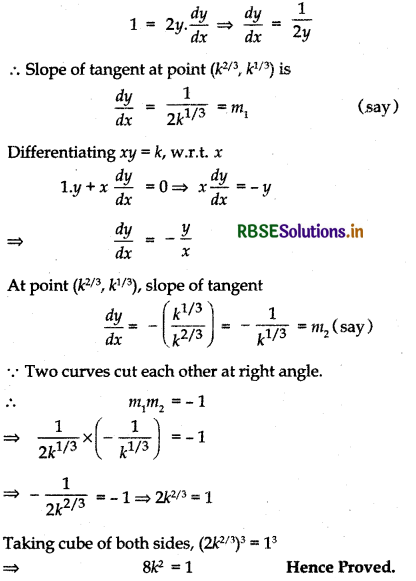
Question 24.
Find the equations of the tangent and normal to the hyperbola \(\frac{x^{2}}{a^{2}}-\frac{y^{2}}{b^{2}}\) = 1 at the point (x0, y0).
Answer:
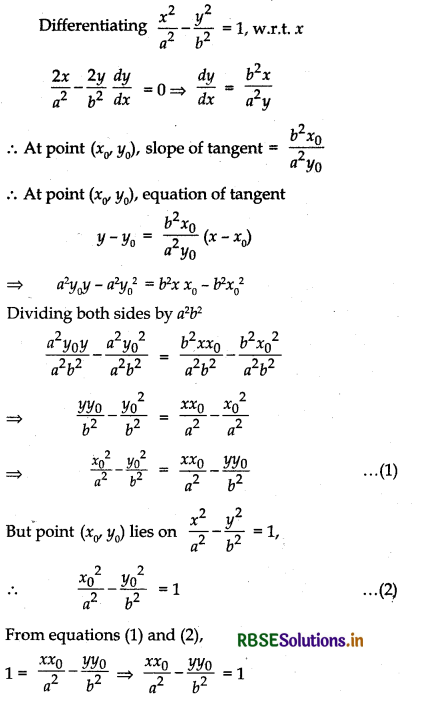
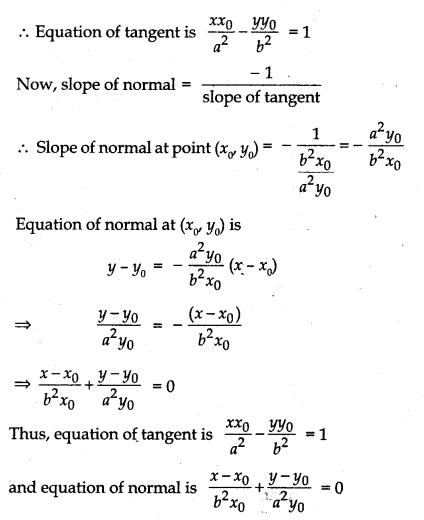

Question 25.
Find the equations of the tangent to the curve Y = \(\sqrt{3 x-2}\) which is parallel to the line 4x - 2y + 5 = 0.
Answer:
Differentiating y = \(\sqrt{3 x-2}\) w.r.t. x
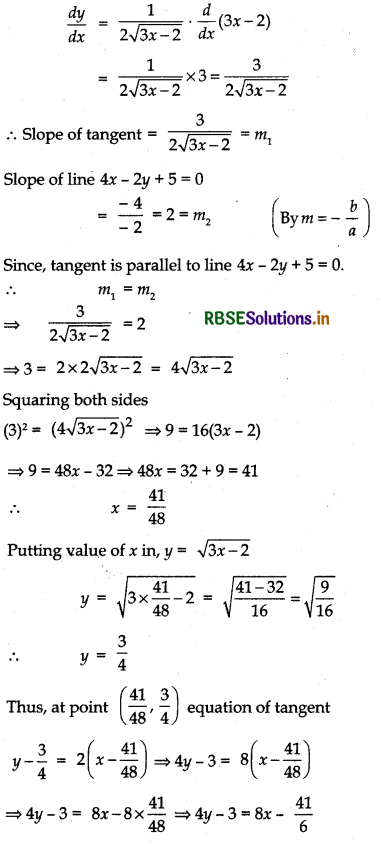
⇒ 6(4y - 3) = 8x × 6 - 41 ⇒ 24y - 18 = 48x - 41
⇒ 48x - 24y - 41 + 18 = 0 ⇒ 48x - 24y - 23 = 0
Thus, equation of tangent is 48x - 24y - 23 = 0
Choose the correct answer in Q. 26 and Q. 27.
Question 26.
The slope of the normal to the curve y = 2x2 + 3 sin x at x = 0 is
(A) 3
(B) \(\frac{1}{3}\)
(C) - 3
(D) - \(\frac{1}{3}\)
Answer:
Differentiating y = 2x2 + 3 sin x, w.r.t. x
\(\frac{d y}{d x}\) = 4x + 3 cos x
At x = 0 at \(\frac{d y}{d x}\) = 4 × 0 + 3 × cos 0 = 3 × 1 = 3
At x = 0 slope of tangent = 3
∴ At x = 0 slope of normal
= \(\frac{-1}{\text { slope of tangent }}=-\frac{1}{3}\)
Thus, (D) is correct.

Question 27.
The line y = x + 1, is a tangent to the curve y2 = 4x at the point
(A) (1, 2)
(B) (2, 1)
(C) (1, - 2)
(D) (- 1, 2)
Answer:
Differentiating y2 = 4x, w.r.t. x
2y.\(\frac{d y}{d x}\) = 4 ⇒ \(\frac{d y}{d x}=\frac{4}{2 y}\)
∴ \(\frac{d y}{d x}=\frac{2}{y}\) (slope of tangent) ....... (1)
And slope of line y = x + 1 = 1 ........ (2)
From equation (1) and (2), \(\frac{2}{y}\) = 1 ⇒ y = 2
Putting value of y in y2 = 4x,
22 = 4x = 4 ⇒ 4x ⇒ x = 1
∴ Point is (1, 2)
∴ Line y = x + 1 is tangent of curve at point (1, 2)
Thus, (A) is correct.

- RBSE Class 12 Maths Notes Chapter 13 Probability
- RBSE Class 12 Maths Notes Chapter 12 Linear Programming
- RBSE Class 12 Maths Notes Chapter 11 Three Dimensional Geometry
- RBSE Class 12 Maths Notes Chapter 10 Vector Algebra
- RBSE Class 12 Maths Notes Chapter 9 Differential Equations
- RBSE Class 12 Maths Notes Chapter 8 Application of Integrals
- RBSE Class 12 Maths Notes Chapter 7 Integrals
- RBSE Class 12 Maths Notes Chapter 6 Application of Derivatives
- RBSE Class 12 Maths Notes Chapter 5 Continuity and Differentiability
- RBSE Class 12 Maths Notes Chapter 4 Determinants
- RBSE Class 12 Maths Notes Chapter 3 Matrices